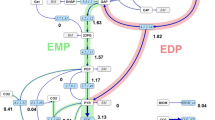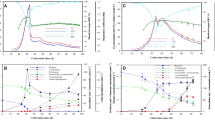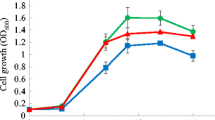Abstract
Metabolic profiling of Pseudomonas fluorescens SBW25 and various mutants derived thereof was performed to explore how the bacterium adapt to changes in carbon source and upon induction of alginate synthesis. The experiments were performed at steady-state conditions in nitrogen-limited chemostats using either fructose or glycerol as carbon source. Carbon source consumption was up-regulated in the alginate producing mutant with inactivated anti-sigma factor MucA. The mucA- mutants (also non-alginate producing mucA- control strains) had a higher dry weight yield on carbon source implying a change in carbon and energy metabolism due to the inactivation of the anti-sigma factor MucA. Both LC–MS/MS and GC–MS methods were used for quantitative metabolic profiling, and major reorganization of primary metabolite pools in both an alginate producing and a carbon source dependent manner was observed. Generally, larger changes were observed among the phosphorylated glycolytic metabolites, the pentose phosphate pathway metabolites and the nucleotide pool than among amino acids and citric acid cycle compounds. The most significant observation at the metabolite level was the significantly reduced energy charge of the mucA- mutants (both alginate producing and non-producing control strains) compared to the wild type strain. This reduction was caused more by a strong increase in the AMP pool than changes in the ATP and ADP pools. The alginate-producing mucA- mutant had a slightly increased GTP pool, while the GDP and GMP pools were strongly increased compared to non-producing mucA- strains and to the wild type. Thus, whilst changes in the adenosine phosphate nucleotide pool are attributed to the mucA inactivation, adjustments in the guanosine phosphate nucleotide pool are consequences of the GTP-dependent alginate production induced by the mucA inactivation. This metabolic profiling study provides new insight into carbon and energy metabolism of the alginate producer P. fluorescens.






Similar content being viewed by others
References
Barrette, W. C., Hannum, D. M., Wheeler, W. D., & Hurst, J. K. (1988). Viability and metabolic capability are maintained by Escherichia coli, Pseudomonas aeruginosa, and Streptococcus lactis at very low adenylate energy-charge. Journal of Bacteriology, 170, 3655–3659.
Behrends, V., Ryall, B., Wang, X. Z., Bundy, J. G., & Williams, H. D. (2010). Metabolic profiling of Pseudomonas aeruginosa demonstrates that the anti-sigma factor MucA modulates osmotic stress tolerance. Molecular BioSystems, 6, 562–569. doi:10.1039/b918710c.
Bolten, C. J., Kiefer, P., Letisse, F., Portais, J. C., & Wittmann, C. (2007). Sampling for metabolome analysis of microorganisms. Analytical Chemistry, 79, 3843–3849. doi:10.1021/ac0623888.
Borgos, S. E., et al. (2012). Mapping global effects of the transcription factor MucA in Pseudomonas fluorescens through genome-scale metabolic modeling. BMC Genome Biology, (submitted).
Canelas, A. B., Ras, C., ten Pierick, A., van Dam, J. C., Heijnen, J. J., & Van Gulik, W. M. (2008). Leakage-free rapid quenching technique for yeast metabolomics. Metabolomics, 4, 226–239. doi:10.1007/s11306-008-0116-4.
Carnicer, M., et al. (2012). Development of quantitative metabolomics for Pichia pastoris. Metabolomics, 8, 284–298. doi:10.1007/s11306-011-0308-1.
Chapman, A. G., Fall, L., & Atkinson, D. E. (1971). Adenylate charge in Escherichia coli during growth and starvation. Journal of Bacteriology, 108, 1072–1086.
Conway, T. (1992). The Entner-Doudoroff pathway—history, physiology and molecular-biology. FEMS Microbiology Reviews, 103, 1–28. doi:10.1016/0378-1097(92)90334-k.
de Koning, W., & van Dam, K. (1992). A method for the determination of changes of glycolytic metabolites in yeast on a subsecond time scale using extraction at neutral pH. Analytical Biochemistry, 204(1), 118–123.
Droste, P., Miebach, S., Niedenfuhr, S., Wiechert, W., & Noh, K. (2011). Visualizing multi-omics data in metabolic networks with the software Omix—a case study. Biosystems, 105, 154–161. doi:10.1016/j.biosystems.2011.04.003.
Ellis, D. I., & Goodacre, R. (2012). Metabolomics-assisted synthetic biology. Current Opinion in Biotechnology, 23, 22–28.
Firoved, A. M., & Deretic, V. (2003). Microarray analysis of global gene expression in mucoid Pseudomonas aeruginosa. Journal of Bacteriology, 185, 1071–1081. doi:10.1128/jb.185.3.1071-1081.2003.
Frimmersdorf, E., Horatzek, S., Pelnikevich, A., Wiehlmann, L., & Schomburg, D. (2010). How Pseudomonas aeruginosa adapts to various environments: a metabolomic approach. Environmental Microbiology, 12, 1734–1747. doi:10.1111/j.1462-2920.2010.02253.x.
Gjersing, E. L., Herberg, J. L., Horn, J., Schaldach, C. M., & Maxwell, R. S. (2007). NMR metabolomics of planktonic and Biofilm modes of growth in Pseudomonas aeruginosa. Analytical Chemistry, 79, 8037–8045. doi:10.1021/ac070800t.
Hassett, D. J., Sutton, M. D., Schurr, M. J., Herr, A. B., Caldwell, C. C., & Matu, J. O. (2009). Pseudomonas aeruginosa hypoxic or anaerobic biofilm infections within cystic fibrosis airways. Trends in Microbiology, 17, 130–138. doi:10.1016/j.tim.2008.12.003.
Hay, I. D., Rehman, Z. U., Ghafoor, A., & Rehm, B. H. A. (2010). Bacterial biosynthesis of alginates. Journal of Chemical Technology and Biotechnology, 85, 752–759. doi:10.1002/jctb.2372.
Kvitvang, H. F. N., Andreassen, T., Adam, T., Villas-Boâs, S. G., & Bruheim, P. (2011). Highly sensitive GC/MS/MS method for quantitation of amino and nonamino organic acids. Analytical Chemistry, 83, 2705–2711. doi:10.1021/ac103245b.
Lien, S. K., Kvitvang, H. F., & Bruheim, P. (2012). Utilization of a deuterated derivatization agent to synthesize internal standards for gas chromatography–tandem mass spectrometry quantification of silylated metabolites. Journal of Chromatography A,. doi:10.1016/j.chroma.2012.05.053.
Lu, W., Bennett, B. D., & Rabinowitz, J. D. (2008). Analytical strategies for LC-MS-based targeted metabolomics. Journal of Chromatography B-Analytical Technologies in the Biomedical and Life Sciences, 871, 236–242. doi:10.1016/j.jchromb.2008.04.031.
Luo, B., Groenke, K., Takors, R., Wandrey, C., & Oldiges, M. (2007). Simultaneous determination of multiple intracellular metabolites in glycolysis, pentose phosphate pathway and tricarboxylic acid cycle by liquid chromatography-mass spectrometry. Journal of Chromatography A, 1147, 153–164. doi:10.1016/j.chroma.2007.02.034.
Martin, D. W., Schurr, M. J., Mudd, M. H., Govan, J. R. W., Holloway, B. W., & Deretic, V. (1993). Mechanism of conversion to mucoidy in Pseudomonas aeruginosa infecting cystic-fibrosis patients. Proceedings of the National academy of Sciences of the United States of America, 90, 8377–8381. doi:10.1073/pnas.90.18.8377.
Mashego, M. R., Rumbold, K., de Mey, M., Vandamme, E., Soetaert, W., & Heijnen, J. J. (2007). Microbial metabolomics: past, present and future methodologies. Biotechnology Letters, 29(1), 1–16.
Meyer, H., Liebeke, M., & Lalk, M. (2010). A protocol for the investigation of the intracellular Staphylococcus aureus metabolome. Analytical Biochemistry, 401, 250–259. doi:10.1016/j.ab.2010.03.003.
Nielsen, J., & Oliver, S. (2005). The next wave in metabolome analysis. Trends in Biotechnology, 23, 544–546. doi:10.1016/j.tibtech.2005.08.005.
Rehm, B. H. A. (2010). Bacterial polymers: biosynthesis, modifications and applications. Nature Reviews Microbiology, 8, 578–592. doi:10.1038/nrmicro2354.
Schnider-Keel, U., Lejbolle, K. B., Baehler, E., Haas, D., & Keel, C. (2001). The sigma factor AlgU (AlgT) controls exopolysaccharide production and tolerance towards desiccation and osmotic stress in the biocontrol agent Pseudomonas fluorescens CHA0. Applied and Environmental Microbiology, 67, 5683–5693. doi:10.1128/aem.67.12.5683-5693.2001.
Smart, K. F., Aggio, R. B. M., Van Houtte, J. R., & Villas-Boâs, S. G. (2010). Analytical platform for metabolome analysis of microbial cells using methyl chloroformate derivatization followed by gas chromatography-mass spectrometry. Nature Protocols, 5, 1709–1729. doi:10.1038/nprot.2010.108.
Sumner, L. W., et al. (2007). Proposed minimum reporting standards for chemical analysis. Metabolomics, 3, 211–221. doi:10.1007/s11306-007-0082-2.
Taylor, J. R. (1997). 7.2 The weighted average. An introduction to error analysis (2nd ed., pp. 174–176). Sausalito, USA: University Science Books.
Taymaz-Nikerel, H., et al. (2009). Development and application of a differential method for reliable metabolome analysis in Escherichia coli. Analytical Biochemistry, 386, 9–19. doi:10.1016/j.ab.2008.11.018.
van der Werf, M. J., Overkamp, K. M., Muilwijk, B., Coulier, L., & Hankemeier, T. (2007). Microbial metabolomics: Toward a platform with full metabolome coverage. Analytical Biochemistry, 370, 17–25. doi:10.1016/j.ab.2007.07.022.
van der Werf, M. J., et al. (2008). Comprehensive analysis of the metabolome of Pseudomonas putida S12 grown on different carbon sources. Molecular BioSystems, 4, 315–327. doi:10.1039/b717340g.
van Gulik, W. M. (2010). Fast sampling for quantitative microbial metabolomics. Current Opinion in Biotechnology, 21, 27–34. doi:10.1016/j.copbio.2010.01.008.
Villas-Boâs, S. G., & Bruheim, P. (2007). The potential of metabolomics tools in bioremediation studies. Omics—A Journal of Integrative Biology, 11, 305–313. doi:10.1089/omi.2007.0005.
Villas-Boâs, S. G., & Bruheim, P. (2007). Cold glycerol-saline: The promising quenching solution for accurate intracellular metabolite analysis of microbial cells. Analytical Biochemistry, 370, 87–97. doi:10.1016/j.ab.2007.06.028.
Villas-Boâs, S. G., Delicado, D. G., Akesson, M., & Nielsen, J. (2003). Simultaneous analysis of amino and nonamino organic acids as methyl chloroformate derivatives using gas chromatography-mass spectrometry. Analytical Biochemistry, 322, 134–138. doi:10.1016/j.ab.2003.07.018.
Villas-Boâs, S. G., Moxley, J. F., Åkesson, M., Stepanopolous, G., & Nielsen, J. (2005). High-throughput metabolic state analysis: the missing link in integrated functional genomics of yeasts. Biochemical Journal, 388, 669–677.
Wentzel, A., Sletta, H., Consortium, S., Ellingsen, T. E., & Bruheim, P. (2012). Intracellular metabolite pool changes in response to nutrient depletion induced metabolic switching in Streptomyces coelicolor. Metabolites, 2, 178–194. doi:10.3390/Metabo2010178.
Winder, C. L., et al. (2008). Global metabolic profiling of Escherichia coli cultures: An evaluation of methods for quenching and extraction of intracellular metabolites. Analytical Chemistry, 80, 2939–2948. doi:10.1021/ac7023409.
Acknowledgments
S.K.L., H.S., T.E.E, S.V., K.V., S.E.F.B. and P.B. would like to thank The Research Council of Norway for financial support. E.C. and R.G. would like to thank the Biotechnology and Biological Sciences Research Council, BBSRC for their financial support. The authors acknowledge the collaborators in the Era-net “Systems Biology of Microorganisms” SysMO project.
Author information
Authors and Affiliations
Corresponding author
Electronic supplementary material
Below is the link to the electronic supplementary material.
Rights and permissions
About this article
Cite this article
Lien, S.K., Sletta, H., Ellingsen, T.E. et al. Investigating alginate production and carbon utilization in Pseudomonas fluorescens SBW25 using mass spectrometry-based metabolic profiling. Metabolomics 9, 403–417 (2013). https://doi.org/10.1007/s11306-012-0454-0
Received:
Accepted:
Published:
Issue Date:
DOI: https://doi.org/10.1007/s11306-012-0454-0




